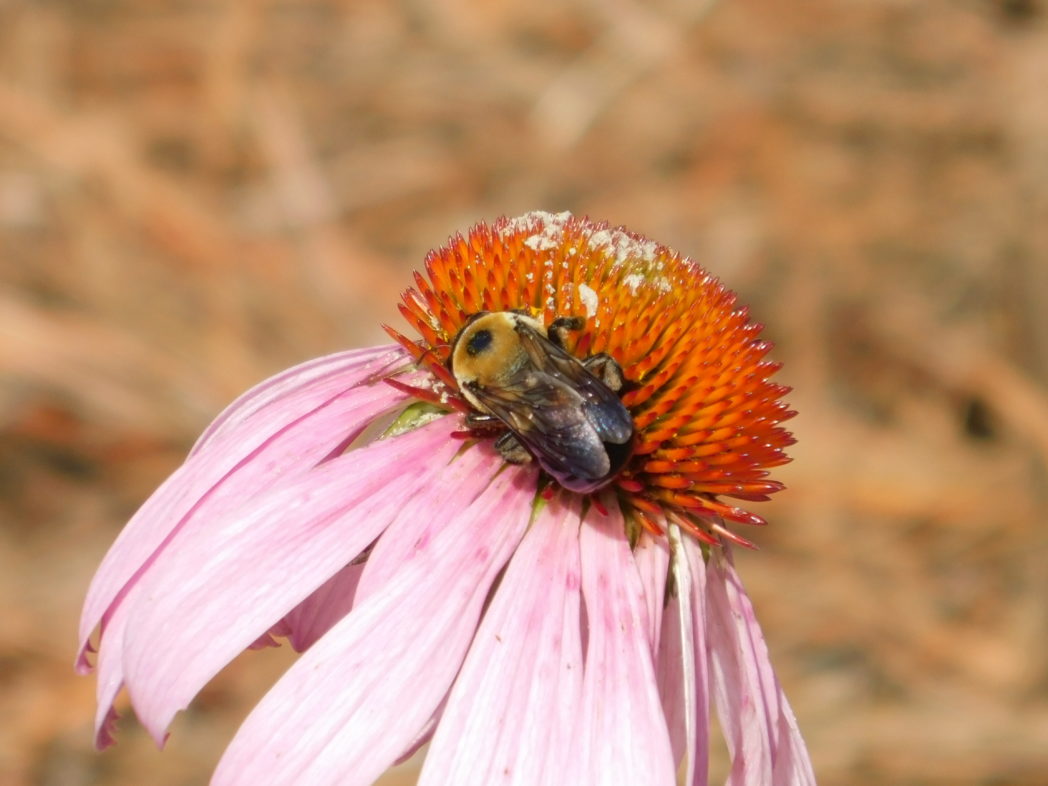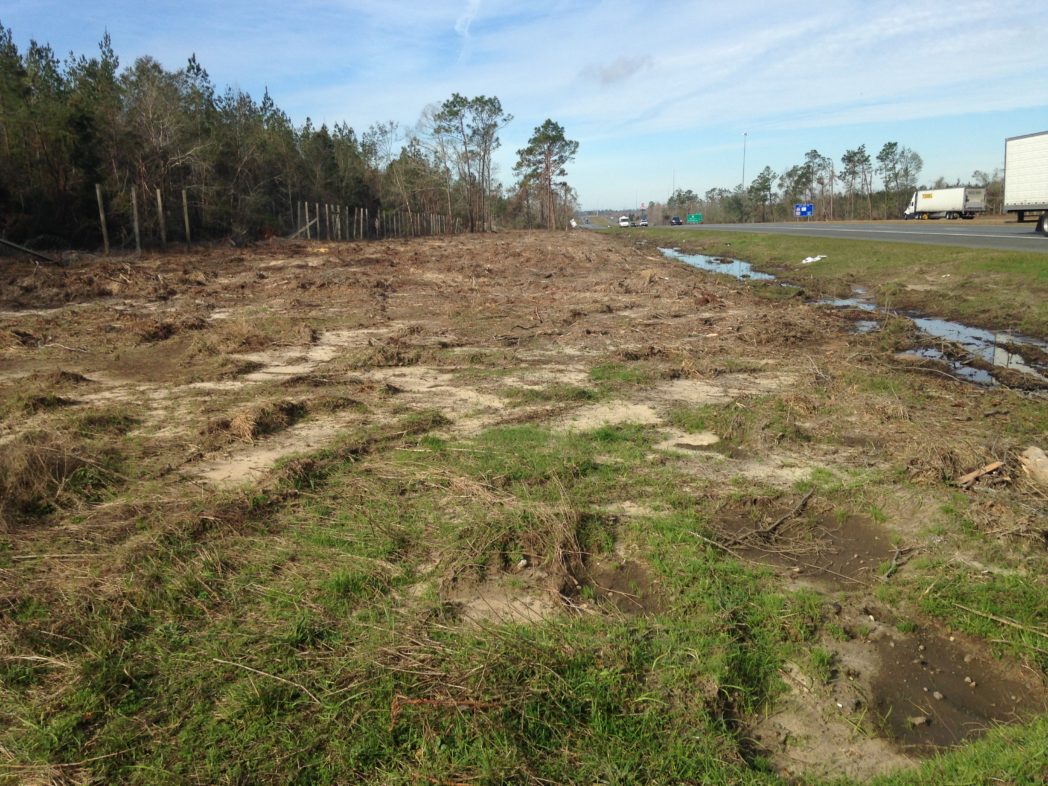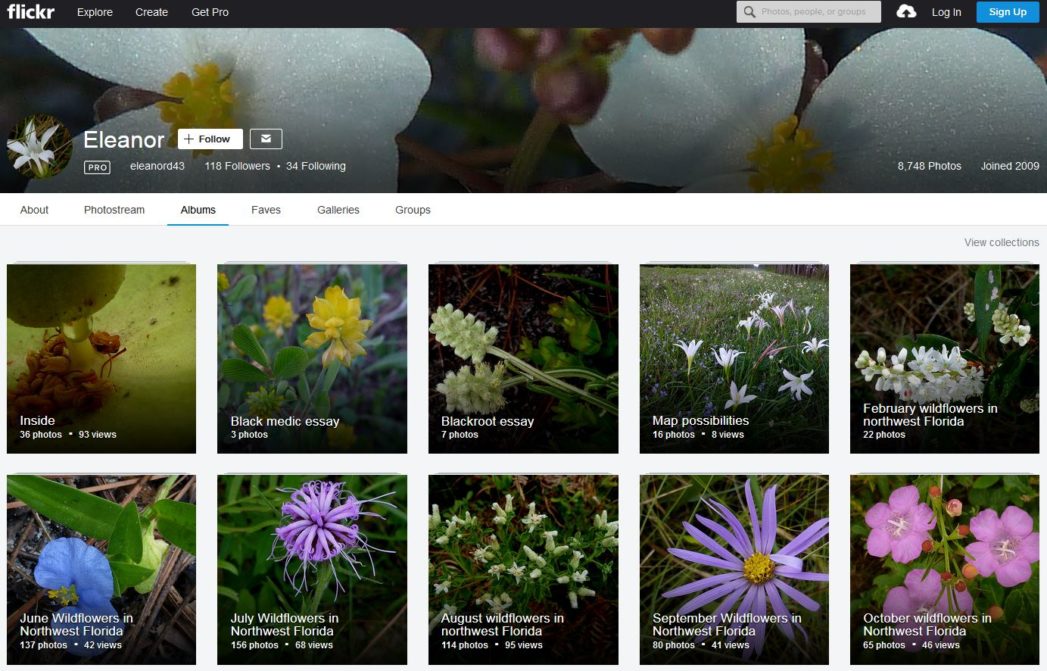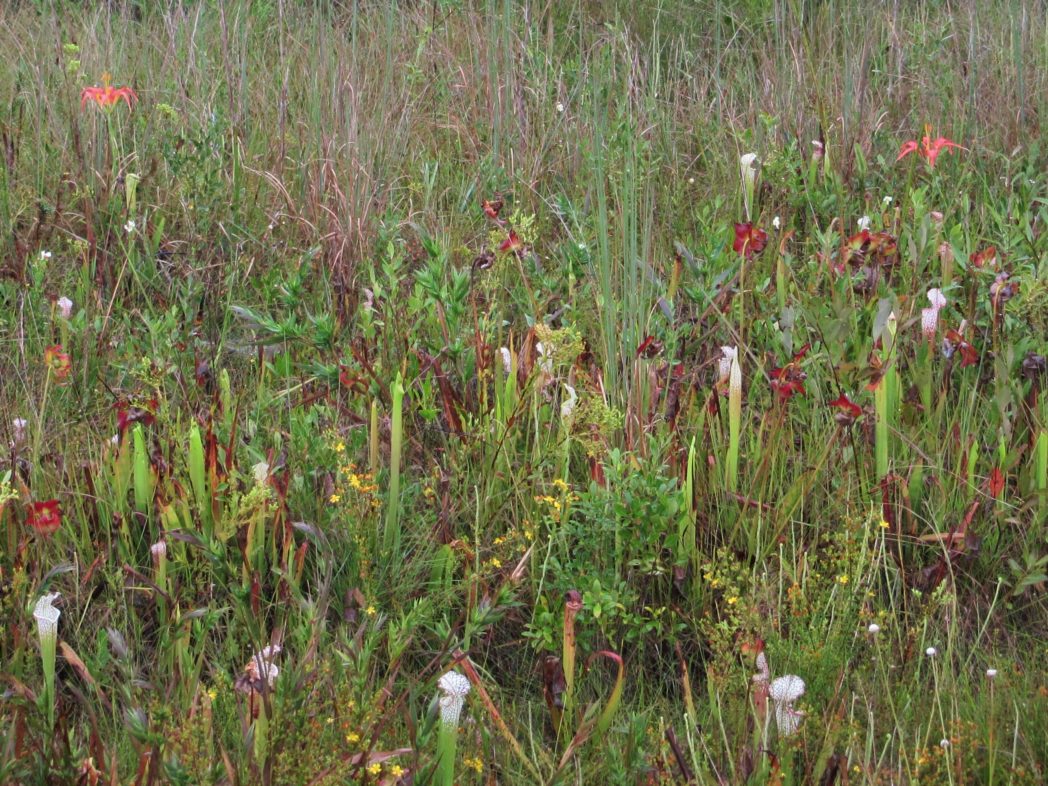2019 Winter Panhandle Wildflower Alliance newsletter
Winter is finally here, although spending New Years Day in shorts and T-shirt didn’t feel very seasonal. It’s a confusing North Florida winter with record December rainfall and temperatures ranging from the 30s to 70s, making dressing for the weather puzzling for plants and people alike. Do I bloom now, do I wait, do I wear shorts or put on a coat?
Let’s take a glance and see what’s happening with wildflowers and hurricane recovery in a few Panhandle counties.
– Liz Sparks, Florida Wildflower Foundation PWA/FDOT Liaison
Post-hurricane native wildflower restoration
Hurricane Michael restoration is slowly making progress, and some landowners in impacted Panhandle counties are making plans to restore habitats, including native wildflowers. This is good news for farmers and beekeepers who are particularly challenged by habitat loss from the storm. They rely on native plants to provide forage for bees and other pollinators that provide essential services to agriculture. This is critical for all of us, as one out of three bites of our food depends on pollinators.
Experts agree that the time for planting wildflower seeds is in the fall, and the focus now is on debris removal and soil prep. In North Florida, the time to sow seed for spring/summer flowering species is from mid-September to late October. Fall flowering species should be sown from mid-September to mid-November.
Jeff Norcini, consultant and FDOT state wildflower specialist, says, “It is too late to seed in January. Moreover, I suspect that there will be a lot of herbaceous vegetation emerging from the seed bank, given that these forests have opened up with all the downed trees. And soil disturbance will enhance seed germ from the seed bank. My concern is that anything that’s seeded [with wildflowers] may get outcompeted. That being said, what emerges from the seed bank may be largely native herbaceous species. My suggestion is to hold off on seeding until fall and see what comes up and where. I would suggest also getting a restoration ecologist involved because that’s the situation you’re dealing with. And any seed used should be from the same ecoregion of the Panhandle.”
Fritz Wettstein, in the Florida Fish & Wildlife Conservation Commission’s Office of Conservation Planning Services, adds, “It wouldn’t hurt for the counties to ask for state funding as part of a Hurricane Michael recovery bill and prep the sites then plant seeds late next fall.”
One prime opportunity to create pollinator habitat is to identify naturally occurring wildflowers along roadsides and reduce mowing of the back slope to allow these native plants to provide forage and cover for pollinators. Not all roadsides are good candidates for reduced mowing. Learn more about preserving roadside wildflowers through modified management.
Homeowners can help create pollinator habitat as well by adding native species of trees, shrubs and wildflowers to landscapes and eliminating invasive species and pesticide use. Learn more.
Where can landowners get help?
- FWC’s Landowner Assistance Program – Contact Arlo Kane in the Northwest Regional office at 850-767-3616. Download this pdf to learn more.
- USDA Natural Resources Conservation Services – Contact Hillary Barnhart at 850-633-7204. She serves Liberty, Franklin, Gulf, and Calhoun counties.
- USDA Disaster Recovery Assistance
- Florida Forestry Services — Forest Recovery after a Hurricane
Where to find seeds and plants
Visit the Florida Wildflower Foundation “Learn to Grow” web page for a wealth of information and links to resources, including where to purchase the native ecotype seeds for zones 8a,8b and 9a. Remember to select the right plant for the right place!
Franklin County
According to Anita Grove, the Apalachicola National Estuarine Research Reserve coastal training program coordinator, the reserve’s native demonstration garden was flooded with about 4 feet of saltwater during the hurricane, destroying saltwater tanks and displays. Fortunately, it looks like Muhly grass, Fakahatchee grass, Blue flag iris, goldenrod and some of the milkweed survived.
And from Lesley Cox, PWA Franklin County lead: County commissioners passed a resolution recognizing October 2018 as Florida Native Plant Month. Most of the large hurricane debris has been removed from U.S. Highway 98 rights of way. It will be interesting to see what wildflowers the ground disturbance brings forth.
Gulf County
Nancy Jones, a member of the Port St. Joe Garden Club and retired executive director and founder of the Blue Heron Nature Preserve in Atlanta, has become the PWA Gulf County lead. Nancy has a special interest in Monarch butterflies and is well versed on the role of native wildflowers in a healthy ecology. Though she is a newcomer to the Panhandle, Nancy has been instrumental in forging contacts with newly elected County Administrator Mike Hammond. This fall, garden club members encouraged Gulf County commissioners to send a letter to FDOT acknowledging its passage of a Wildflower Resolution in April 2017 and asking that modified mowing be implemented. Unfortunately, Hurricane Michael rearranged priorities, and the commission and garden club agreed to table any action until January 2019.
Santa Rosa
The Santa Rosa County Commission passed a Wildflower Resolution in July 2016. About 70 miles of naturally occurring native roadside wildflowers are being managed, thanks to efforts by the Public Works Department, directed by Stephen Furman, and the UF/IFAS Santa Rosa County Master Gardeners, directed by Residential Horticulture Agent Mary Salinas with coordination by Suzanne Spencer, PWA county lead. Wildflower Areas are along five county roads and five state roads maintained by FDOT.
The county is home to the state’s largest pitcherplant community. Four of the five county roads and two of the state roads have significant numbers of the state-endangered Whitetop pitcherplants (Sarracenia leucophylla), which are easily seen from the road. Yellow pitcherplant (S. flava) and the state-threatened Parrot pitcherplant (S. psittacina) also can be found in wet ditches on two of the county roads. Another wildflower that has benefited from reduced mowing is the state-threatened Pine lily (Lilium catesbaei). A visit to Santa Rosa County during spring and fall wildflower seasons will reveal a wide variety and large populations of many beautiful native wildflower species. Read a report on Santa Rose’s program.
Wakulla County
PWA members in Wakulla County had several successes 2018, including recruiting volunteers to plant a bounty of native plants in Sopchoppy’s Depot Park (see a report below).
The year ahead is packed with promising events, including the15th annual Arbor Day celebration last weekend in Crawfordville, where nearly 1,000 trees were given away. They started as bare root seedlings that were grown for a year by the Wakulla County Garden Club through a partnership with the state of Florida and National Wildlife Federation’s Trees for Wildlife program. In addition, Longleaf pine seedlings were given away by the Florida Forest Service. The St Marks National Wildlife Refuge’s Milkweed Project distributed Swamp milkweed (Asclepias perennis) plants. Panhandle Wildflower Alliance volunteers helped the Florida Wildflower Foundation’s PWA/FDOT Liaison Liz Sparks distribute FWF publications and answer questions about Panhandle wildflowers.

Volunteers plant wildflowers at Sopchoppy park
Butterflies will soon be frequent visitors to Sopchoppy’s Depot Park, thanks to teams of hard-working volunteers who planted more than 300 native wildflowers, ferns, climbing vines and native grasses in November. A bee was even spotted on a Purple coneflower as volunteers were leaving.
Newly planted species include Lanceleaf tickseed, Blazing star, Stokes’ aster, Swamp sunflower, Starry rosinweed, Tall ironweed, Wild blue phlox, Woodland pinkroot, Tropical sage, Purple coneflower, Blackeyed Susan, White wild indigo, Spotted beebalm, Coralbean, Blue mistflower, Goldenrod and five species of native milkweed. Five species of climbing vines will be trained to grow along the front fence, around the pavilion posts and up the trunks of two large trees.
Additional wildflowers will be planted next spring. More than a dozen uncommon wildflowers that are not commercially available are being grown from locally collected seeds in the Refuge greenhouse over the winter. These include Zigzag silkgrass, Feay’s prairieclover, Godfrey’s blazing-star, Scarlet calamint, Cucumberleaf dune sunflower, Cottony goldenaster, Scareweed, Summer farewell and October flower. The Florida Native Plant Society’s Sarracenia Chapter plans to create plant labels and a map of the park’s plants to help visitors identify them.

Storm debris removal and invasives are District 3 priorities
Dustie Moss, FDOT District 3 wildflower coordinator, says that Hurricane Michael debris removal efforts are still underway, with a vast majority of the debris being trees. District 3 will continue to remove downed, dead and dying trees while the Division of Forestry leads roadway reforestation.
Bob Farley, the district’s vegetation management specialist says, “We are entering a period of extreme diligence for monitoring and control of exotic invasive plants. With the canopy on the ground and wind aided propagules everywhere in the heart of the district, the struggle before us is to make sure native species have an equal chance for space. What could be more advantageous for Japanese Climbing Fern that having the canopy destroyed and laying on the ground providing support?
“The challenge for the department right of way is greater than just debris removal. Erosion control on slopes disturbed by heavy equipment, as well as fighting invasion from exotic plants, will be ongoing for years. This effort will necessarily preclude, or at least closely coincide with, any reforestation.“

How to enjoy Eleanor’s fabulous wildflowers on flickr
By Eleanor Dietrich
For the past few years, I have been putting my wildflower photos in the online program Flickr. It makes it easy for me to upload, organize, tag and describe my photos. It autoloads photos from my computer to a photostream, allowing me to create albums. I can also combine albums into collections, such as Orchids of Northwest Florida (my geographic area of focus). You can reach my Flickr site at www.flickr.com/photos/wildflowersflorida.
When you click an album to open it, it displays all that album’s photos, including a description of the album in the header (you usually have to also click on “show more” in the header to see it all). If you want to see more about a particular photo, you can click on it and it will enlarge to provide descriptive information (you may need to scroll down to see it).
Finding a particular wildflower species
On the top line of the Flickr page above, a search box on the right can be used to enter in the name of a flower. When you activate the search, a variety of responses will come up: My albums containing that flower, all the photos of the flower that I have, and photos of that flower taken by other people. Because every photo is dated, you can search by date as well. When the results are displayed, you can click on any one of them to get to the album or the flower.
I am in the process of creating albums by month, for photos I have taken in northwest Florida. In addition to an album of the different flowers for the month, in the description section for each flower (scroll down to see it below the photo) I am in the process of adding a link to another album just of that flower, which I call an essay. In an essay album, I start with the bigger picture of the habitat, or the whole plant, then proceed down to a close up of the flower and seeds (if I have a photo of them). On the far right, just above the rows of albums, click “View my collections” to get to them; they consist of a group of albums based on a topic. I have a number of them that include the species of a particular genus, such as Meadowbeauties (Rhexia).

